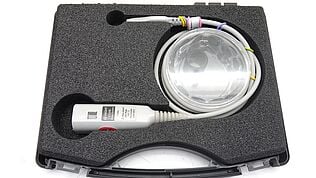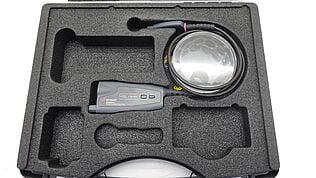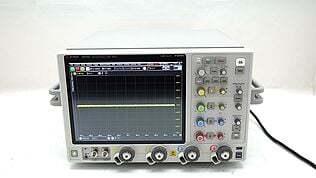- Introduction
- What is a Time Base?
- Why Is It Called a Time Base?
- Reference Point for Time
- Standardized Unit of Measurement
- Importance of Time Base in Oscilloscopes
- Horizontal Axis Control
- Ensuring Uniformity
- Synchronization
- Components of the Time Base System
- Sweep Generators
- Trigger Systems
- Key Features and Adjustments in Oscilloscope's Time Base
- Sweep Speed
- Time/Div Control
- Delayed Time Base
- Oscilloscope Time Base Features and Applications
- Conclusion
- Whenever You’re Ready, Here Are 5 Ways We Can Help You
Think of an orchestra: each instrument playing its part, yet all relying on the conductor to keep time. In the electronic world, the oscilloscope is akin to this orchestra, with the time base serving as the unsung maestro. It ensures every waveform and signal stays in rhythm, telling a coherent story of voltage over time. Let's delve into the importance and nuances of this pivotal component in the oscilloscope's performance.
Buy Oscilloscopes at a Great Discount
What is a Time Base?
Time base in an oscilloscope refers to the system or circuitry responsible for creating a horizontal sweep across the screen, thereby representing the progression of time. As the beam sweeps horizontally, the vertical deflection of the beam represents the input signal voltage at that instant in time.
| Key Takeaway |
|---|
| Time base in an oscilloscope is integral to the accurate representation and analysis of waveforms, enabling control over how signals are plotted over time. It's not just a feature but a fundamental tool that shapes the clarity and precision of measurements. |
Why Is It Called a Time Base?
The term "time base" isn't just a random selection of words; it plays a foundational role in the functionality of an oscilloscope.
Reference Point for Time
At its core, the time base establishes a clear reference for time. As an oscilloscope plots the intricate signal waveforms, the time base ensures that this display is anchored to a consistent and comprehensible timeline. This foundation allows users to interpret and analyze signal behaviors in the context of time.
Standardized Unit of Measurement
Further, the time base isn’t just about providing a backdrop. It quantifies the passage of time on the oscilloscope screen. This quantification is typically denoted as seconds per division (s/div). This means:
- When you're looking at the screen grid, each horizontal division represents a specific time interval.
- By adjusting the time base, you can expand or compress this interval, thereby zooming in on a fleeting signal event or widening the view to capture prolonged signal behaviors.
In essence, the time base provides both a temporal canvas and a ruler, making the oscilloscope's display both meaningful and measurable. Without it, we'd have a moving signal with no understanding of its progression in time.

Importance of Time Base in Oscilloscopes
Horizontal Axis Control
At its heart, the time base dictates the movement of the electron beam as it moves horizontally across the screen. This journey of the beam maps the input signal's evolution over a given time frame.
Ensuring Uniformity
- Consistency: Like a clock's unwavering tick, the time base guarantees a uniform sweep from one edge of the screen to the other.
- Repetitiveness: Much like the sun setting and rising without fail, after each sweep concludes, the time base ensures an immediate reset, thereby facilitating a continuous and seamless display of the waveform.
Synchronization
Synchronization is the linchpin ensuring the visual coherence of waveforms. Without it, understanding a signal's behavior would be akin to watching a movie with out-of-sync audio. Imagine trying to decipher a constantly moving target; it's both frustrating and futile. Without synchronization:
- Drifting dilemma: Waveforms would continually shift or drift across the screen, making meaningful analysis an exercise in futility.
- Missing the moment: Capturing singular, non-recurring events, akin to shooting stars in the vast sky, would be next to impossible.
Components of the Time Base System
Modern oscilloscopes are advanced tools designed to offer a precise view into the intricate world of electrical signals. At the very core of these tools is the time base system, the mechanism ensuring every waveform's accurate capture and representation. Let's sequentially break down the key components of this vital system.
Sweep Generators
In analog oscilloscopes, sweep generators are essential for directing the electron beam's horizontal movement across the oscilloscope screen.
- Main sweep: This is the default controller for the primary horizontal display, offering a comprehensive view of the signal's evolution over a set time frame.
- Delayed sweep: For those moments when you need a more detailed perspective, the delayed sweep comes into play. It focuses on a specific segment of the main waveform, presenting a magnified view of that interval.
Trigger Systems
A consistent and reliable start to the horizontal sweep is critical. That's where the trigger system steps in, acting as the synchronization cornerstone for each signal representation, both in analog and digital scopes.
- Edge triggering: As one of the most widespread types, edge triggering launches the horizontal sweep when the signal crosses a predefined voltage level. It's the go-to method for observing distinct voltage transitions.
- Pulse width triggering: Some applications require the length of a signal's pulse. Pulse width triggering answers this call, activating the sweep based on the pulse's specific duration.
- Video triggering: Catering to video signals, this trigger is synchronized with the distinct attributes of video waveforms. Whether it's aligning with frame rates or sync pulses, video triggering ensures clarity when analyzing video patterns.
Beyond these, contemporary oscilloscopes frequently feature a spectrum of specialized triggering techniques. These ensure versatility, catering to diverse applications and nuanced signal types.
Key Features and Adjustments in Oscilloscope's Time Base
The time base in an oscilloscope is like the steering wheel of a car. It doesn't make the car move, but it governs the direction and ensures that you navigate your route effectively. Similarly, the time base dictates how electrical signals are visualized on an oscilloscope. Here, we’ll dive deeper into its key features and the adjustments that engineers commonly use to ensure clarity and precision in waveform observation.
Sweep Speed
The sweep speed plays a pivotal role in ensuring that the signal's waveform is represented accurately and conveniently on the oscilloscope screen. Typically, sweep speed is expressed in terms of 'seconds per division' (s/div), denoting how fast the oscilloscope plots the waveform across the screen.
- Depending on the nature of the signal, for high-frequency signals like digital ones, you need a fastersweep speed, often in the range of nanoseconds per division.
- Conversely, more languid signals like those from audio sources require a slower sweep pace, often necessitating settings in milliseconds per division.
Time/Div Control
Think of the "Time/Div" or "Horizontal Scale" knob as the zoom feature on a camera. This control allows users to modulate the time base, effectively expanding or compressing the visual representation of the waveform.
- Clockwise turn: The sweep speed amplifies, reducing the time each division represents. It's like zooming out to see more of the signal's landscape.
- Counter-clockwise turn: The sweep speed slackens, extending the time for each division. It's akin to zooming in for a more detailed view of the waveform's features.
Delayed Time Base
Modern oscilloscopes, especially those with dual or multiple time bases, often come equipped with a feature known as the delayed time base. This function acts as a magnifying glass, allowing users to delve deeper into specific segments of a captured waveform.
- The power to activate: After capturing the overarching landscape of a waveform, users can turn on the delayed time base. It’s the equivalent of selecting a specific scene from a broad panorama.
- Zooming in: With the delayed time base activated, users can tweak the time base to focus intently on a particular portion of the waveform. This functionality is invaluable when examining transient events or anomalies within a larger signal, offering an in-depth look into the minutiae without losing the broader context.
In essence, the time base offers a range of features and adjustments that empower professionals to visualize electrical signals in both their size and detail.
Oscilloscope Time Base Features and Applications
| Feature | Description | User Adjustment | Practical Application |
| Sweep Speed | Determines the plotting speed of the waveform on the screen. | Set in terms of 'seconds per division' (s/div). | Some digital signals might require faster speeds like nanoseconds per division. Audio signals need settings in milliseconds per division. |
| Time/Div Control | Expands or compresses the visual representation of the waveform. | Turn knob clockwise to increase sweep speed, counter-clockwise to decrease sweep speed. | Helps in zooming in or out on the waveform to observe detailed transitions or a broader view. |
| Delayed Time Base | Allows a focused view on a specific segment of a waveform. | Activate after capturing a waveform. Adjust to inspect a particular section. | Perfect for analyzing specific transient events or minor anomalies in a larger signal. |
Conclusion
The time base of an oscilloscope is more than just a feature; it's a foundational element that determines how electrical signals are visualized and interpreted. For professionals who rely on oscilloscopes for detailed analyses and diagnostics, understanding the nuances of the time base is indispensable. It not only ensures the accuracy of measurements but also impacts the clarity with which waveforms are presented.
As you tackle complex analyses, the right equipment is not a luxury—it's a necessity. And for the most precise and accurate measurements, Keysights certified equipment is the only choice. Visit the Keysight Used Equipment Store for premium used oscilloscopes, network analyzers, meters and more. Explore the selection today and equip yourself with the tools essential for your projects, all at an affordable price.

Browse Oscilloscopes at a Great Discount
Select up to 3 instruments to compare
Enable Notifications
In order to use this feature, you need to enable notifications.
Manage notification preferences
Whenever You’re Ready, Here Are 5 Ways We Can Help You
- Browse our Premium Used Oscilloscopes.
- Call tech support US: +1 800 829-4444
Press #, then 2. Hours: 7 am – 5 pm MT, Mon– Fri - Talk to our sales support team by clicking the icon (bottom right corner) on every offer page
- Create an account to get price alerts and access to exclusive waitlists.
- Talk to your account manager about your specific needs.








































